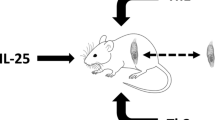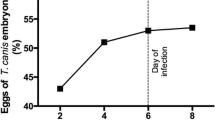Abstract
In the present paper, we assess the relationship between the expression of IFN-γ and the development of clinical signs in Echinostoma caproni-infected mice. For this purpose, we studied the course of the infection in three mouse strains: ICR (CD-1®) (a host of high compatibility with E. caproni), BALB/c (a prototypical Th2 strain), and BALB/c deficient for IFN-γ mice (IFN-γ−/−). Infection in ICR mice is characterized by the elevated expression of IFN-γ and iNOS in the intestine concomitantly with the lack of clinical signs. In contrast, the infection was more virulent in BALB/c and IFN-γ-deficient mice that developed a severe form of the disease together with the absence of IFN-γ expression. The disease was more severe in IFNγ−/− mice in which the disease was lethal during the few first weeks of the infection. The analysis of different parameters of the infection in each host strain showed that most of the features were similar in the three mouse strains, suggesting the IFN-γ plays a central role in that protection against severe disease. Thus, IFN-γ seems to play a dichotomous role in the infection facilitating the parasite establishment, but it may also benefit mice since it protects the mice from morbidity and mortality induced by the parasite.







Similar content being viewed by others
References
Artis D, Potten CS, Else KJ, Finkelman FD, Grencis RK (1999) Trichuris muris: host intestinal epithelial cell hyperproliferation during chronic infection is regulated by interferon-gamma. Exp Parasitol 92:144–153
Brunet LR (2001) Nitric oxide in parasitic infections. Int Immunopharmacol 1:1457–1467
Castilow EM, Olson MR, Meyerholz DK, Varga SM (2008) Differential role of gamma interferon in inhibiting pulmonary eosinophilia and exacerbating systemic disease in fusion protein-immunized mice undergoing challenge infection with respiratory syncytial virus. J Virol 82:2196–21207
Chen N, Bellone CJ, Schriewer J, Owens G, Fredrickson T, Parker S, Buller RM (2011) Poxvirus interleukin-4 expression overcomes inherent resistance and vaccine-induced immunity: pathogenesis, prophylaxis, and antiviral therapy. Virology 409:328–337
Christensen NO, Simonsen PE, Odaibo AB, Mahler H (1990) Establishment, survival and fecundity of Echinostoma caproni (Trematoda) infections in hamsters and jirds. J Helminthol Soc Wash 57:104–107
Cliffe LJ, Potten CS, Booth CE, Grencis RK (2007) An increase in epithelial cell apoptosis is associated with chronic intestinal nematode infection. Infect Immun 74:1556–1564
Falcone M, Rajan AJ, Bloom BR, Brosnan CF (1998) A critical role for IL-4 in regulating disease severity in experimental allergic encephalomyelitis as demonstrated in IL-4-deficient C57BL/6 mice and BALB/c mice. J Immunol 160:4822–4830
Fried B, Huffman JE (1996) The biology of the intestinal trematode Echinostoma caproni. Adv Parasitol 38:311–368
Fujino T, Fried B (1993) Expulsion of Echinostoma trivolvis (Cort 1914) Kanev 1985 and retention of E. caproni Richard 1964 (Trematoda, Echinostomatidae) in C3H mice: pathological, ultrastructural, and cytochemical effects on the host intestine. Parasitol Res 79:286–292
Fulkerson PC, Rothenberg ME (2008) origin, regulation and physiological function of intestinal eosinophils. Best Pract Res Clin Gastroenterol 22:411–423
Humphreys NE, Xu D, Hepworth MR, Liew FY, Grencis RK (2008) IL-33, a potent inducer of adaptive immunity to intestinal nematodes. J Immunol 180:2443–2449
Kato Y, Manabe T, Tanaka Y, Mochizuki H (1999) Effect of an orally active Th1/Th2 balance modulator, M50367, on IgE production, eosinophilia, and airway hyperresponsiveness in mice. J Immunol 162:7470–7479
Keklikoglu N, Koray M, Kocaelli H, Akinci S (2008) iNOS expression in oral and gastrointestinal tract mucosa. Dig Dis Sci 53:1437–1442
Klein D (2002) Quantification using real-time PCR technology: applications and limitations. Trends Mol Med 8:257–260
Krämer S, Schimpl A, Hünig T (1995) Immunopathology of interleukin (IL) 2-deficient mice: thymus dependence and suppression by thymus-dependent cells with an intact IL-2 gene. J Exp Med 182:1769–1776
Kühn R, Löhler J, Rennick D, Rajewsky K, Müller W (1993) Interleukin-10-deficient mice develop chronic enterocolitis. Cell 75:263–274
Lawrence CE, Paterson JC, Higgins LM, MacDonald TT, Kennedy MW, Garside P (1998) IL-4-regulated enteropathy in an intestinal nematode infection. Eur J Immunol 28:2672–2684
Lawrence CE, Paterson JC, Wei XQ, Liew FY, Garside P, Kennedy MW (2000) Nitric oxide mediates intestinal pathology but not immune expulsion during Trichinella spiralis infection in mice. J Immunol 164:4229–4234
Li P, Lin JE, Chervoneva I, Schulz S, Waldman SA, Pitari GM (2007) Homeostatic control of the crypt-villus axis by the bacterial enterotoxin receptor guanylyl cyclase C restricts the proliferating compartment in intestine. Am J Pathol 171:1847–1858
Livak KJ, Schmittgen TD (2001) Analysis of relative gene expression data using real-time quantitative PCR and the 2-ΔΔCT method. Methods 25:402–408
Mahler H, Christensen NO, Hindsbo O (1995) Studies on the reproductive capacity of Echinostoma caproni (Trematoda) in hamsters and jirds. Int J Parasitol 25:705–710
Martinez FO, Helming L, Gordon S (2009) Alternative activation of macrophages: an immunologic functional perspective. Annu Rev Immunol 27:451–483
McDermott JR, Humphreys NE, Forman SP, Donaldson DD, Grencis RK (2005) Intraepithelial NK cell-derived IL-13 induces intestinal pathology associated with nematode infection. J Immunol 175:3207–3213
Mizoguchi A, Mizoguchi E, Chiba C, Spiekermann GM, Tonegawa S, Nagler-Anderson C, Bhan AK (1996) Cytokine imbalance and autoantibody production in T cell receptor-alpha mutant mice with inflammatory bowel disease. J Exp Med 183:847–856
Mowat AM (1989) Antibodies to IFN-gamma prevent immunologically mediated intestinal damage in murine graft-versus-host reaction. Immunology 68:18–23
Muñoz-Antoli C, Sotillo J, Monteagudo C, Fried B, Marcilla A, Toledo R (2007) Development and pathology of Echinostoma caproni in experimentally infected mice. J Parasitol 93:854–859
Odaibo AB, Christensen NØ, Ukoli FMA (1988) Establishment, survival and fecundity in Echinostoma caproni (Trematoda) infections in NMRI mice. Proc Helminthol Soc Wash 55:265–269
Odaibo AB, Christensen NØ, Ukoli FMA (1989) Further studies on the population regulation in Echinostoma caproni infections in NMRI mice. Proc Helminthol Soc Wash 56:192–198
Simonsen PE, Bindseil E, Køie M (1989) Echinostoma caproni in mice: studies on the attachment site of an intestinal trematode. Int J Parasitol 19:561–566
Smith NC (1989) The role of free oxygen radicals in the expulsion of primary infections of Nippostrongylus brasiliensis. Parasitol Res 75:423–438
Sotillo J, Trelis M, Cortes A, Fried B, Marcilla A, Esteban JG, Toledo R (2011) Th17 responses in Echinostoma caproni infections in hosts of high and low compatibility. Exp Parasitol 129:307–311
Stange J, Hepworth MR, Rausch S, Zajic L, Kühl AA, Uyttenhove C, Renauld JC, Hartmann S, Lucius R (2012) IL-22 mediates host defense against an intestinal intracellular parasite in the absence of IFN-γ at the cost of Th17-driven immunopathology. J Immunol 188:2410–2418
Toledo R, Fried B (2005) Echinostomes as experimental models for interactions between adult parasites and vertebrate hosts. Trends Parasitol 21:251–254
Toledo R, Espert A, Carpena I, Muñoz-Antoli C, Fried B, Esteban JG (2004) The comparative development of Echinostoma caproni (Trematoda: Echinostomatidae) adults in experimentally infected hamsters and rats. Parasitol Res 93:439–444
Toledo R, Esteban JG, Fried B (2006a) Immunology and pathology of intestinal trematodes in their definitive hosts. Adv Parasitol 63:285–365
Toledo R, Monteagudo C, Espert A, Fried B, Esteban JG, Marcilla A (2006b) Echinostoma caproni: intestinal pathology in the golden hamster, a highly compatible host, and the Wistar rat, a less compatible host. Exp Parasitol 112:164–171
Toledo R, Esteban JG, Fried B (2009) Recent advances in the biology of echinostomes. Adv Parasitol 69:147–204
Trelis M, Sotillo J, Monteagudo C, Fried B, Marcilla A, Esteban JG, Toledo R (2011) Echinostoma caproni (Trematoda): differential in vivo cytokine responses in high and low compatible hosts. Exp Parasitol 127:387–397
Acknowledgments
This work was supported by the Projects PROMETEO/2009/081 from Conselleria d’Educació, Generalitat Valenciana (Valencia, Spain) and INV-AE13-136845 de la Universitat de Valencia (Valencia, Spain). This work has been carried out while the first author (A.C.) was a recipient of a pre-doctoral fellowship from the Vicerectorat d’Investigació i Política Científic de la Universitat de València (Valencia, Spain). This research complies with the current laws for animal health research in Spain.
Author information
Authors and Affiliations
Corresponding author
Rights and permissions
About this article
Cite this article
Cortes, A., Sotillo, J., Muñoz-Antoli, C. et al. Intestinal IFN-γ production is associated with protection from clinical signs, but not with elimination of worms, in Echinostoma caproni infected-mice. Parasitol Res 113, 2037–2045 (2014). https://doi.org/10.1007/s00436-014-3851-7
Received:
Accepted:
Published:
Issue Date:
DOI: https://doi.org/10.1007/s00436-014-3851-7




